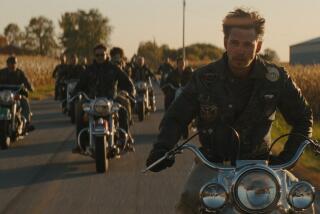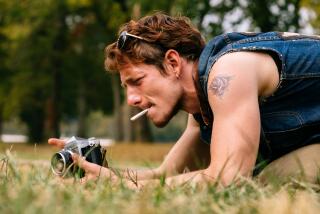Movie Reviews : âBad Girlsâ: A High-Fashion Western
They swear and carouse and kick up dust. They charge across the crimson horizon on their trusty steeds. They blast grown men right out of their skivvies with their pistols. They wear color-coordinated outfits. Theyâre the Bad Girls of âBad Girlsâ but theyâre really Good Girls, or at least Good Bad Girls. Whatever righteous wrath they expend, however smudged their cheeks, they always manage to look as stylish as a fashion catalogue layout for Hot Nights in the Old West.
The timing for this film is right: This is the movie era for women with guns and an attitude. âBad Girlsâ combines the renascence of the Western with post-âThelma & Louiseâ syndrome. It displays four of our busiest and most popular actresses--Madeleine Stowe, Andie MacDowell, Mary Stuart Masterson and Drew Barrymore--in a vehicle as form-fittingly tailored for them as âThe Magnificent Sevenâ was for its actors. The high concept is preposterously low-slung and amusing--even more so because director Jonathan Kaplan plays the material straight. Heâs trying to be John Ford in designer jeans.
Audiences may not enjoy this movie in quite the way it was intended--as some kind of revisionist feminist spree--but thatâs all right. Sometimes movies are enjoyable for all the wrong reasons. Whatâs ticklish about âBad Girlsâ is how it shoehorns feminist anger into a plot that amply provides for stylish sashaying.
The Bad Girls begin the movie as prostitutes in a Bible-Belted Colorado town, which they flee after their leader, Cody Zamora (Stowe), plugs an unruly customer. Chased by two Pinkerton detectives into Texas, the girls set their sights on a sawmill that Anita (Masterson) thinks could be turned into a thriving business. (She had planned to purchase the homestead with her husband before he died of cholera and she became a prostitute.)
The sawmill idea meets with surprisingly little resistance. âWe sold our bodies,â says one of the girls. âWhy canât we sell some wood?â This is the spirit that made the West. (A friend referred to this part of the film as âFried Green Tamales.â) But en route to the mill complications ensue. Codyâs grubstake gets swiped by the scurvy, stubbly bandido (James Russo) she used to run around with. (He flourishes a whip and, in a modest skinny-dip scene, we see the lash marks on her back.) Eileen (MacDowell) gets captured and jailed but makes googly eyes at her jailer, William Tucker (James LeGros), and escapes into the night.
A handsome stranger (Dermot Mulroney) keeps popping up for Cody at the most opportune moments, helping to treat her back wounds and heartaches. Heâs quite possibly the most Liberated Guy in Western movie history--a Shane with sensitivity training. He could care less that Cody is characterized on the reward posters as the Honky Tonk Harlot.
It helps, of course, that, with the exception of Tucker, all the other men in this movie, most notably Robert Loggiaâs Frank Jarrett, seem to be out of a Sam Peckinpah road company. This reinforces the filmâs feminist point: Times were tough for single women on the range. As a breed, men were sadistic scamps. The Bad Girls bring them into line with pistol and Gatling gun.
One reason you canât take the revisionism in this movie all that seriously--besides the have-your-cake-and-eat-it-too fashion prancing--is because Kaplan keeps hauling up buckets of hoary Western cliches. If youâre going to rework a genre, a good place to start is with the dialogue, and there are far too many lines in this movie like the one where Cody looks longingly at her old lover and says, âWe had some times, didnât we?â (At least weâre spared seeing those times in flashback.) The film could use more scenes like the dirty-nasty one where the girls skin snakes for dinner and Cody says, âCanât tell one meat from another--just like men.â Screenwriters Ken Friedman and Yolande Finch may have had more interesting ideas than the ones that ended up in âBad Girls.â The scenario seems hemmed in by the usual Hollywood honcho fears that the women might actually show some rough edges, some rage--might actually be (gasp) unsympathetic .
Despite the life-is-tough stuff, all the Bad Girls, save Cody, seem oddly untouched by the mayhem. MacDowellâs beatific smiles are the same ones sheâs been proffering in movie after movie--sheâs starting to seem more than a bit ga-ga. Barrymore could be posing for a new perfume--Hellcat, perhaps?
Stowe, however, invests so much passion in her role that she single-handedly keeps the film honest--at least whenever sheâs on screen. Her rage in this film is the real thing. Itâs an extraordinary performance, but then Stowe is often extraordinary. When will she get a starring role in a movie that really challenges her? She has the ability to transcend pulp even as she exposes it. Itâs a great gift to have in a cruddy movie era but putting Stowe behind a Gatling gun is not, to put it gently, the best use of her talents.
* MPAA rating: R, for Western-type violence. Times guidelines: It includes brief nudity, much gunplay.
âBad Girlsâ
Madeleine Stowe: Cody Zamora
Mary Stuart Masterson: Anita Crown
Andie MacDowell: Eileen Spenser
Drew Barrymore: Lilly Laronette
A 20th Century Fox presentation of a Ruddy Morgan production. Director Jonathan Kaplan. Producers Albert S. Ruddy, Andre E. Morgan and Charles Finch. Executive producer Lynda Obst. Screenplay by Ken Friedman and Yolande Finch. Cinematographer Ralf Bode. Editor Jane Kurson. Costumes Susie DeSanto. Music Jerry Goldsmith. Production design Guy Barnes. Set decorator Michael Taylor. Running time: 1 hour, 51 minutes.
* In general release throughout Southern California.
More to Read
Only good movies
Get the Indie Focus newsletter, Mark Olsen's weekly guide to the world of cinema.
You may occasionally receive promotional content from the Los Angeles Times.










